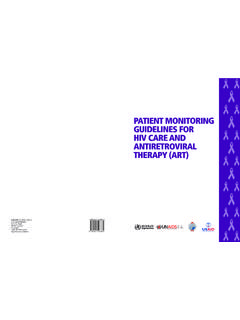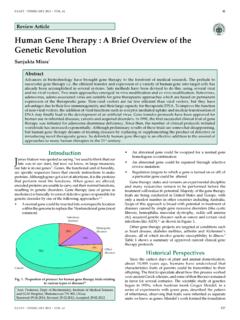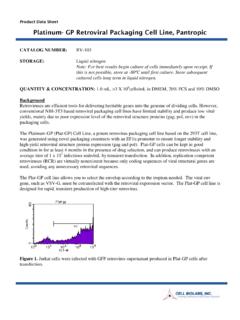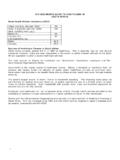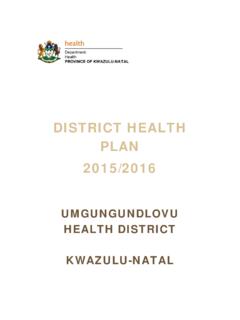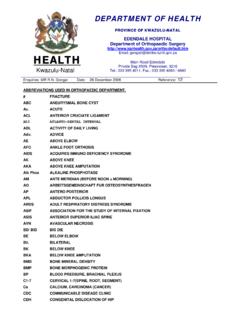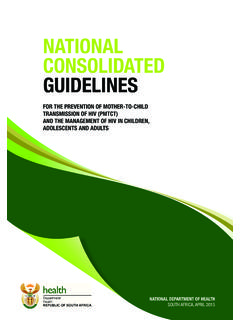Transcription of National Anti-retroviral Therapy Guidelines - WHO
1 National Centre for AIDS and STD Control (NCASC) Nepal National Anti-retroviral Therapy Guidelines National ART Guidelines 2009 Page 2 National Anti-retroviral Therapy Guidelines 2009 Government of Nepal Ministry of Health & Population National Centre for AIDS & STD Control (NCASC) Teku, Kathmandu National ART Guidelines 2009 Page 3 Medical knowledge is constantly and rapidly changing, particularly in relation to HIV/AIDS. Readers are strongly advised to confirm that the information (especially with regards to drug doses and usage) complies with the latest standards of practice. Technical Experts Group National ART Guidelines 2009 Page 4 Dr. Laxmi Raj Pathak, Director, NCASC Dr. Krishna Kumar Rai, Director, NCASC Dr. Ramesh Kharel, Deputy Director, NC ASC Prof.
2 Sashi Sharma, Lead Consultant, Professor of Medicine, TUTH Dr. Sushil Shakya, Sr. Medical Officer, Bir Hospital Prof. Prem Khadga, Professor of Medicine, TUTH Prof. Jyoti Sharma, Professor of Gyn/Obg, TUTH Dr. Basudev Pandey, Sr. Medical Officer, Teku Hospital Dr. Laxman Shrestha, Associate Professor, TUTH Dr. Saroj Ojha, Associate Professor, TUTH Dr. L. B. Thapa, Sr. Medical Officer, Teku Hospital Dr. D. P. Bhusal, Sr. Medical Officer, Teku Hospital Dr. Kiran Shakya, Sr. Medical Officer, Bhaktapur Hospital Dr. Kiran Raj Pandey, Medical officer, Doti District Hospital Dr. Dinesh Binod Pokharel, Associate Professor, TUTH Dr. Amaya Maw-Naing, Medical Officer, WHO Dr. Durga Bhandari, Technical Team Leader, FHI Dr. Lisa Stevens, Clinical Services Specialist, FHI Dr. Atul Dahal, National Professional Officer, WHO Mr. Rajan Kumar Bhattarai, Programme Coordinator, NCASC/UNDP Mr. Prakash Pandey, Programme Offi cer, NCASC/UNDP Mr. Rajesh Khanal, Programme Officer, NCASC/UNDP Ms.
3 Sujeeta Bajracharya, M&E Officer, NCASC/UNDP Foreword National ART Guidelines 2009 Page 5 Within 3 decades of its discovery, HIV AIDS has become the number one killer infectious disease of mankind. While on one hand the disease is taking young lives, on the other it is tearing the social fabric apart, thereby perpetuating a vicious cycle of poverty and disease that seems to ignite it in the first place. At per cent prevalence levels in the country, our HIV caseload is hardly modest. While preventive efforts to bring down prevalence levels are ongoing, the importance of treatment, care and support of those that have already been infected cannot be over emphasized. The government of Nepal has made an effort to rapidly scale up Anti-retroviral Therapy , so that treatment may be readily accessible to those in need. anti retroviral Therapy is today available at 25 ART centers in the country and we intend to rapidly scale up the number of such centers in the near future.
4 These Guidelines are part of the ongoing effort to rapidly scale up antiretroviral Therapy throughout the country. These Guidelines are meant for use by doctors, nurses and paramedics that are actively involved in care of the patients. A lot of effort has gone into the preparation of these Guidelines , and we have been able to incorporate lessons learnt from our experience with ART during the last 5 years, when the first edition of the Guidelines came out. I would like to take this opportunity to thank Prof. Sashi Sharma, Lead consultant, the members of the Technical Experts Group as well as the Technical Working Group for the incessant effort they have put in bringing out these Guidelines . I would also like to thank our partner organizations- the WHO, UNDP, and FHI as well as all the other individuals and organizations for their time and effort in bringing out these Guidelines . Dr. Krishna Kumar Rai Director, National Center for AIDS and STD Control Abbreviations National ART Guidelines 2009 Page 6 3TC lamivudine ABC abacavir AIDS acquired immune deficiency syndrome ALC absolute lymphocyte count ALT alanine aminotransferase (also known as SGPT) APV amprenavir ARV Anti-retroviral ART Anti-retroviral Therapy CBC complete blood count CD cluster of differentiation CMV cytomegalovirus d4T stavudine DC differential leucocyte count ddI didanosine EFV efavirenz ELISA enzyme linked immunosorbent assay HCW health care worker HIV human immunodeficiency virus IDV indinavir LPV lopinavir LPV/r lopinavir boosted with ritonavir MTCT mother-to child transmission (of HIV)
5 NFV nelfinavir NNRTI non-nucleoside reverse transcriptase inhibitor NsRTI nucleoside analog reverse transcriptase inhibitor NtRTI nucleotide analog reverse transcriptase inhibitor NVP nevirapine OI opportunistic infection PEP post exposure prophylaxis PCP pneumocystis jiroveci pneumonia PCR polymerase chain reaction PI protease Inhibitor /r low dose ritonavir RTV ritonavir SGPT serum glutamic pyruvic transaminase (also known as ALT). SQV saquinavir RT reverse transcriptase STI sexually transmitted infections TB tuberculosis TDF tenofovir disoproxil fumarate TC total leucocyte count VCT voluntary counseling and testing (of HIV) VL viral load WHO world health organization ZDV zidovudine, (also known as AZT) TABLE OF CONTENTS National ART Guidelines 2009 Page 7 I. Background ---------------------------------------- ---------------------------------------- ------------8 II. Principles of Antiretroviral Therapy ---------------------------------------- -------------------9 III.
6 Indications for Antiretroviral Therapy ---------------------------------------- ---------------11 IV. Antiretroviral Drugs and their actions ---------------------------------------- ---------------13 V. Choice of Antiretroviral Regimen ---------------------------------------- ---------------------19 VI. Monitoring ---------------------------------------- ---------------------------------------- -----------24 VII. Changing Antiretroviral Drugs ---------------------------------------- ------------------------30 VIII. Monitoring of HIV drug resistance ---------------------------------------- --------------------36 IX. Discontinuation or interruption of anti retroviral Therapy -----------------------------37 X. Antiretroviral Therapy in Pregnancy and the Prevention of Mother-to-Child Transmission (MTCT) of HIV------------------------------------- ---------39 XI. Tuberculosis and Antiretroviral Therapy ---------------------------------------- -----------45 XII.
7 Hepatitis C co-infection and ART ---------------------------------------- ----------------------49 XIII. Hepatitis B co-infection and ART ---------------------------------------- ----------------------49 XIV. Immune Reconstitution Inflammatory Syndrome (IRIS) ------------------------------ 49 XV. Cotrimoxazole Prophylaxis in Adults ---------------------------------------- ----------------50 XVI. Post Exposure Prophylaxis (PEP) of HIV------------------------------------- ---------------52 XVII. Management of HIV/AIDS in Infants and Children-------------------------------- --------59 XVIII. Antiretroviral Therapy in Injecting Drug Users ---------------------------------------- ----64 XIX. Annexes ---------------------------------------- ---------------------------------------- ----------------68 I. Background National ART Guidelines 2009 Page 8 The first case of AIDS was reported in 1981 in the USA. Since then, AIDS has become the most devastating and threatening disease of humans.
8 More than 60 million people have been infected and about 33 million people are estimated to be currently living with HIV, among whom one-third are between 15-24 years of age. Initially, the epidemic was concentrated in the African continent. But it continues to spread in Asia, particularly in South Asia. In South and South East Asia, there are approximately 4 million people living with HIV/AIDS. In Nepal, the first case of HIV/AIDS was diagnosed in 1988. The major mode of transmission in Nepal is heterosexual. The available data show that there is a high prevalence of HIV in high-risk groups such as injecting drug users and female sex workers. Currently, it is estimated that there are approximately 70,000 people living with HIV/AIDS in Nepal, with an estimated 3,000 deaths (2002) annually. In 1986, antiretroviral Therapy was initially introduced in other countries with the first drug Zidovudine (ZDV). Over the next few years, other antiretroviral drugs (NRTIs, NNRTIs and Pls) were introduced.
9 Initially, mono and dual therapies were used but the problem of resistance emerged. At present, 3 or more ARV drugs are recommended worldwide for the treatment of people with HIV infection. Since the use of combination Therapy , this disease has been transformed into a chronic condition. However, the use of antiretroviral Therapy is not the final answer to HIV/AIDS prevention and care programs. The delivery of effective care and antiretroviral treatment for people living with HIV/AIDS in the poorest countries is considered an urgent priority and is a complementary program to HIV transmission prevention programs. Initially, antiretroviral Therapy was very expensive and so, unaffordable in most developing countries. As drugs are increasingly affordable, the development of Guidelines on the appropriate and rational use of ART has become relevant in developing countries. These current Guidelines are intended basically for use by medical doctors who prescribe ARV Therapy to the people infected with HIV/AIDS.
10 Guidelines for the treatment and management of HIV infection have been produced in a number of countries of Europe, USA, Australia, India, Thailand, etc. and by WHO/UNAIDS. While these Guidelines attempt to represent the current state of knowledge, it is inevitable that as HIV/AIDS is a rapidly evolving medical field new information will change therapeutic choices and preferences. This should be kept in mind while using these Guidelines . II. Principles of Antiretroviral Therapy National ART Guidelines 2009 Page 9 Goals of Antiretroviral Therapy Maximal and durable suppression of viral load. Restoration and/or preservation of immunologic function. Reduction of HIV-related morbidity and mortality. Improvement of quality of life of HIV infected persons. Prevention of Mother to Child Transmission (PMTCT). Post Exposure Prophylaxis (PEP). Preconditions for starting Antiretroviral Therapy The following specific facilities and services are desirable before starting Antiretroviral Therapy Availability of HIV voluntary counseling and testing (VCT) services along with follow up counseling services.










